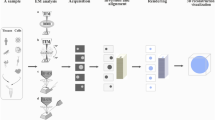Abstract
Direct immunogold labeling and histological mapping of membrane proteins is demonstrated in Lexan-stabilized SDS-washed freeze-fracture replicas of complex tissues. Using rat brain and spinal cord as primary model systems and liver as a ”control” tissue to identify preparation and labeling artifacts, we demonstrate the presence of connexin43 in freeze-fractured gap junctions of identified and mapped astrocytes and ependymocytes, and confirm the presence of connexin32 in freeze-fractured gap junctions in liver. In addition, the simultaneous double-labeling of dissimilar proteins (connexin43 and aquaporin-4) is demonstrated in gap junctions and square arrays, respectively, in the plasma membranes of astrocytes and ependymocytes. Finally, double-side shadowing and conventional staining methods are used to reveal the extent of biological material present at the time of labeling and to investigate the dynamics of membrane solubilization, the primary artifacts that occur during labeling, and several factors limiting quantitative analysis.
Similar content being viewed by others
Author information
Authors and Affiliations
Additional information
Received: 2 September 1998 / Accepted: 24 November 1998
Rights and permissions
About this article
Cite this article
Rash, J., Yasumura, T. Direct immunogold labeling of connexins and aquaporin-4 in freeze-fracture replicas of liver, brain, and spinal cord: factors limiting quantitative analysis. Cell Tissue Res 296, 307–321 (1999). https://doi.org/10.1007/s004410051291
Issue Date:
DOI: https://doi.org/10.1007/s004410051291




